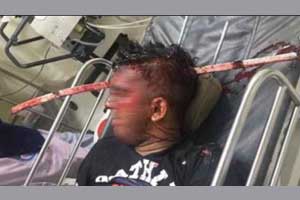- Home
- Editorial
- News
- Practice Guidelines
- Anesthesiology Guidelines
- Cancer Guidelines
- Cardiac Sciences Guidelines
- Critical Care Guidelines
- Dentistry Guidelines
- Dermatology Guidelines
- Diabetes and Endo Guidelines
- Diagnostics Guidelines
- ENT Guidelines
- Featured Practice Guidelines
- Gastroenterology Guidelines
- Geriatrics Guidelines
- Medicine Guidelines
- Nephrology Guidelines
- Neurosciences Guidelines
- Obs and Gynae Guidelines
- Ophthalmology Guidelines
- Orthopaedics Guidelines
- Paediatrics Guidelines
- Psychiatry Guidelines
- Pulmonology Guidelines
- Radiology Guidelines
- Surgery Guidelines
- Urology Guidelines
Iron rod removed from Kolkata's youth's skull

KOLKATA: A 3.5-feet-long iron rod was successfully removed by doctors here from the skull of a youth, who suffered severe brain damage after the metal pierced through his forehead and the cranium in a car accident and the patient discharged on Tuesday.
The 24-year-old M Taraque was released from the Apollo Gleneagles hospital during the day, a month after the critical brain surgery, said to be unprecedented in eastern India.
"Taraque suffered a massive car accident on April 28 in which a 3.5 ft long iron rod of the roadside divider broke and went through his forehead leaving him profusely bleeding and with very little life expectancy when he was brought to the hospital," said Binod Kumar Singhania, Consultant Neuro Surgeon at the hospital.
The doctor revealed they had to get on with the surgery without much prior knowledge about the extent of the patient's brain damage as it was difficult to conduct a CT scan with such a big piece of metal stuck in his head.
They eventually removed the rod through an unique endoscopic process with proper haemostasis - a process which causes bleeding to stop.
"The case was extremely tricky as the biggest challenge was to minimize the bleeding inside the skull after removing the metal rod. As the brain remains enclosed inside the skull, too much bleeding could have damaged a large number of brain cells that may have led to the patient's death," the doctor said.
Singhania admitted that he hasn't performed such an operation in his 30-year-long career as a neurosurgeon.
"The operation was successful and it was found that the patient did not suffer any major vessel damage in the accident. He is currently stable. However, there is a problem with the movements of his speech and the right side limbs, which would need post-operative care like physiotherapy and speech therapy," he said.
Another doctor in the hospital lauded the success f the operation as a "miracle" and stressed that such accident victims should be immediately transferred to a specialised medical care without any attempt to remove the rod.
"It is a miraculous success as most patients with such injuries can't be saved. It is important that he was immediately brought to the hospital and no attempts were made to remove the rod from his skull.
"Otherwise, the situation would have been fatal as the patient would have profusely bled from the wound," added Suresh Ramasubban, senior consultant of pulmonary critical care department in the hospital.

Disclaimer: This site is primarily intended for healthcare professionals. Any content/information on this website does not replace the advice of medical and/or health professionals and should not be construed as medical/diagnostic advice/endorsement or prescription. Use of this site is subject to our terms of use, privacy policy, advertisement policy. © 2020 Minerva Medical Treatment Pvt Ltd